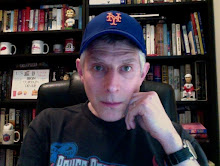 |
| Independence Day |
It was July 4, 1993 -- 25 years ago today -- and I was in Binghamton, New York with my pal Jeff at the second stop of an upstate minor league excursion. A day earlier we'd been at historic Dunn Field in Elmira for some Class A NY-Penn League action.
Now we'd moved up to the AA Eastern League affiliate of the New York Mets. On the B-Mets roster were outfielder Butch Huskey, infielders Aaron Ledesma and Quilvio Veras, plus pitchers Jason Jacome and Pete Walker, prospects all, but none could hold a figurative candle to the big kid on the opposing Canton-Akron Indians.
Long mired in the nether regions of the American League's Eastern Division, the parent Cleveland Indians were on the cusp of a renaissance. Among Ramirez's teammates were future big leaguers David Bell, Brian Giles and Herbert Perry. But that big kid, he stood out.
Two years earlier Manny had been drafted out of George Washington High School, in the Washington Heights section of upper Manhattan. Emblematic of the changing mosaic of the city, the same school had produced Hall of Famer Rod Carew and in an earlier era, U.S. Secretary of State Henry Kissinger and Federal Reserve Chairman Alan Greenspan.
 |
| Ninety feet and a cloud of dust: Ryan Martindale beats the tag of Andy Dziadkowiec as Julio Peguero and Brian Giles look on. |
At roughly the halfway point of the Eastern League season, Ramirez was batting a robust .339, pounding out 102 hits in 301 at bats over 77 games. He'd belted 15 homers, driven in 68 runs and even stole two bases.
Giles too was a comer, but his .303 average came with just five dingers and 36 ribbies.
Huskey, 22, a projected slugger for the Mets, had hit 13 homers and driven in 55 runs, while batting just .248. Over the summer he added a dozen circuit clouts and 43 more RBI's, meriting a September call up to The Show.
 |
The numbers, through July 3, 1993 |
So too did Manny. He'd play just just a dozen more games for the C-A tribe -- hitting two more taters and knocking in 11 -- before being moved up to AAA Charlotte and then the big club, where he took his place among Jim Thome, Albert Belle, Carlos Baerga and Kenny Lofton.
Two years later, the Indians, now in the AL Central, went to the World Series for the first time since 1954, starting a run of six first place finishes in seven seasons with a second pennant in 1997.
Ramirez finished runner-up for the 1994 AL Rookie of the Year award, behind the Kansas City Royals' Bob Hamelin and blossom into a perennial all star and most valuable player candidate.
He'd play for two World Series winners too, albeit for the Boston Red Sox, not the Indians and be suspended -- twice -- for using performance-enhancing drugs, the second time ending his career.
That punishment likely killed his Hall of Fame prospects, despite a lifetime batting average of .312, 555 home runs and 1831 RBIs. The drug in question: human chorionic gonadtropin, a not-so-manly female fertility drug also known as HCG, which can also boost testosterone production in men.
Just Manny being Manny.
But about Elmira
An hour's drive west of Binghamton, but a world away, Elmira's Dunn Field Municipal Stadium exists almost out of time, a pre-World War II relic that stands in stark contrast to the B-Mets' utilitarian Binghamton Municipal Stadium, which opened in 1992.
 |
| New Marlins and old Pioneers |
For decades it served as a NY-Penn League or Eastern League outpost, the Elmira Pioneers affiliating with teams including the St. Louis Cardinals and Browns, the Philadelphia Athletics and Phillies and, for one magical season, 1969, for the expansion San Diego Padres and Seattle Pilots.
Don Zimmer once played there. The legendary Steve Dalkowski too. So did Rabbit Maranville, Davey Johnson, Wade Boggs and Oil Can Boyd.
 |
| The Pioneers and their MLB affiliates, from the '93 program/yearbook |
Like a lot of small northern cities, Elmira's population is declining, and with it, its baseball fortunes. After the 1995 season, the team moved to Massachusetts, re-affiliating with the Red Sox as the Lowell Spinners. Subsequent editions of the Pioneers played in the independent Northeast, Northern and CanAm Leagues.
Now they're part of the Perfect Game Collegiate Baseball League, which sounds, well, perfect.
-- Follow me on Twitter @paperboyarchive

No comments:
Post a Comment